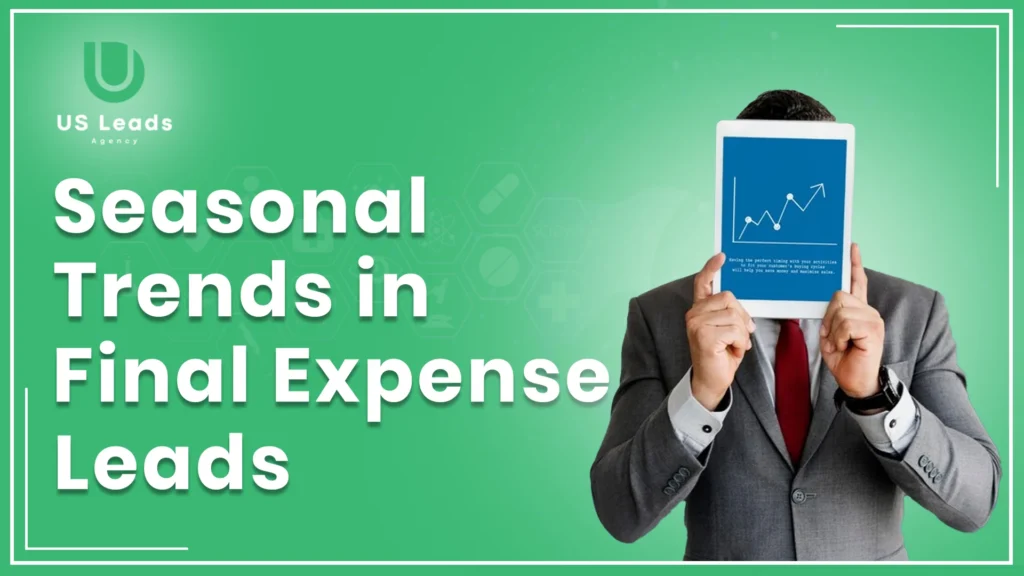
Understanding the seasonal demand for final expense insurance leads is crucial for insurance agents and agencies to optimize their marketing strategies, improve sales, and allocate resources effectively. Unlike other insurance products, the demand for final expense insurance is relatively steady throughout the year, but there are specific times when the demand peaks or fluctuates. Various factors, including socioeconomic conditions, holidays, and major life events influence these trends.
This article delves into the seasonal final expense trends in lead demand and how insurance agents can adapt to these changes to maximize their conversions and overall sales performance.
Key Takeaways:
- Winter and Year-End Surge: Demand for final expense insurance spikes during the holidays as people review their financial plans and prioritize family.
- Post-Tax Season Demand: From April to June, demand increases as consumers allocate tax refunds and focus on financial planning.
- Summer Slump: Demand tends to slow during the summer months as families focus on vacations and other expenses.
- Life Events Drive Demand: Significant life events like retirements or health scares often lead to a surge in interest in final expense insurance.
- Fall Financial Focus: As summer ends, demand increases from September to November, with consumers returning to personal financial planning.
- Economic Conditions Impact Demand: Economic factors play a role in consumer confidence and willingness to invest in final expense policies.
Table of Contents
Seasonal Final Expense Trends That Impact Lead Demand:
1. Winter And Year-End Surge:
One of the most significant seasonal trends in final expense lead demand occurs during the winter months, particularly toward the end of the year. Many people start reviewing their financial situations and estate plans during this time, especially around the holidays. As individuals spend more time with family, they are reminded of the importance of final expense insurance to prevent their loved ones from facing financial burdens after their passing.
Additionally, year-end financial planning often triggers discussions about life insurance, including final expense policies. Agents can capitalize on this by ramping up their marketing efforts between November and December, targeting consumers who may want to complete their financial planning before the new year.
2. Post-Tax Season Interest:
Another spike in final expense lead demand occurs in the months following tax season, typically from April to June. Once individuals have settled their taxes, they may find themselves with additional disposable income or refunds that can be allocated toward purchasing final expense insurance. Tax-related financial planning often prompts people to evaluate their overall life insurance needs, making it an opportune time for agents to target prospects.
Marketing strategies during this time should focus on how tax refunds can be invested in securing final expense policies, offering peace of mind for the future.
3. Summer Slump:
The summer months, particularly June through August, tend to see a slight decline in final expense lead demand. Many families prioritize vacations, summer activities, and other expenses during this time, which can divert attention from final expense insurance needs.
While the demand may not be as high during this period, agents should still maintain a consistent presence through digital channels, educating prospects about the benefits of final expense insurance. By positioning themselves as a steady resource, agents can remain top-of-mind once consumers are ready to refocus on their insurance needs.
4. Life Events And Final Expense Demand:
Final expense lead demand often correlates with significant life events, such as the birth of grandchildren, retirements, or health scares within families. These personal milestones remind individuals of the importance of securing a policy that will cover their funeral costs and other final expenses. While these events can happen year-round, agents should be prepared to engage with prospects who have recently experienced such life changes.
Customizing marketing messages to reflect the emotional and practical importance of final expense insurance during these events can lead to increased conversions.
5. Fall Financial Focus:
As summer ends and children return to school, individuals often shift their focus back to personal finances. September through November typically sees an uptick in final expense lead demand as people settle into their post-summer routines and begin planning for the year ahead. This period is a good time for agents to engage with prospects who are looking to secure their end-of-life plans before the holiday season begins.
Agents can run fall-specific campaigns highlighting the affordability and simplicity of final expense policies, making it easier for prospects to take action.
6. Influence Of Economic Conditions:
While not strictly seasonal, economic conditions can have a profound impact on final expense lead demand. During times of economic downturn or uncertainty, such as during a recession, people may delay or forego purchasing final expense insurance. Conversely, when the economy is stable or improving, consumers may feel more confident in making long-term financial commitments.
Agents should monitor economic trends and adjust their marketing strategies accordingly, promoting final expense policies as affordable and essential, even during difficult financial times.
Conclusion – Seasonal Final Expense Trends:
By understanding and anticipating these seasonal final expense trends, insurance agents can better tailor their outreach and marketing strategies to capture leads during peak demand periods. Staying proactive during slow periods and maximizing engagement during high-demand times ensures a steady flow of prospects, ultimately leading to more conversions and a stronger client base for the future.
